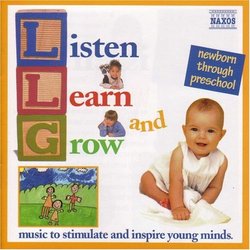No-brainer compilation
John Abbott | San Francisco, CA | 08/07/2000
(2 out of 5 stars)
"A whole sub-genre of the compilation CD has emerged over the last few years, based on the premise that music - and especially Mozart's music - can stimulate the developing brain. That notion first hit the headlines in 1993, when physicist Gordon Shaw published early results of his research exploring the relationship between music, intelligence and learning. There are now many best-selling compilations, including this one and Sony's Build Your Baby's Brain, Volumes 1 and 2. They are perfectly acceptable mixtures of popular and tuneful short movements from the classics. This disk and Sony's first volume both include the Romance from Mozart's "Eine kliene Nachtmusik," Bach's "Air on a G String" and Pachabel's Canon, and use various movements from Handel's "Water Music" and Vivaldi's "Four Seasons." Musically, there's little to distinguish them from literally hundreds of similar compilations. But Shaw himself has recently been hitting back over the hype that others have built up around his work. He says that recordings such as these, and books such as Don Campbell's "The Mozart Effect", which proposes music as the cure for just about everything from cancer to war "have nothing to do with reality." Shaw's work has indicated that, under the right circumstances, music may indeed boost the brain's mathematical and reasoning capabilities. But the effect is often only temporary, and is very hard to measure.Moreover, compilation CDs such as these have tended towards the lighter side of Mozart and the classics, whereas Shaw has based all his research on just one Mozart work, the Sonata for Two Pianos in D Major (K448). He specifically chose the piece because of its "breathtaking complexity." It isn't included in either of these CDs. The developing brain, it appears, needs more challenging stuff than compilations aimed at mass market sales are prepared to offer. Those really interested in Shaw's theories need to spend a hefty sun on his own book, Keeping Mozart in Mind, which comes with a CD recording of the Sonata for Two Pianos by Murray Perahia and Radu Lupu, and a "spatial-temporal animation reasoning" software program for children, designed to help the stimulation process along."


 Track Listings (14) - Disc #1
Track Listings (14) - Disc #1